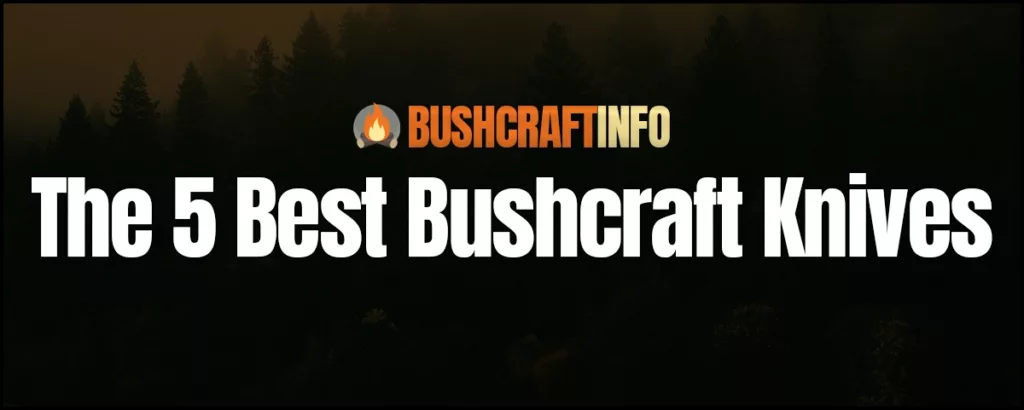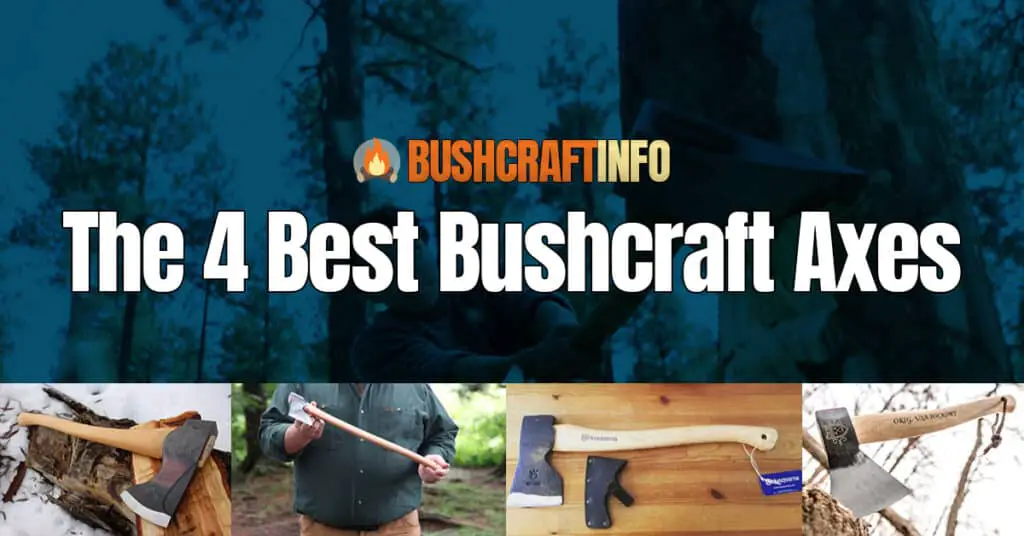There is a lot of confusion online over what the best type of bushcraft knife is, how many knives you should bring with you, what length should your blade be, etc.
In today’s post, I will answer each of these questions for you to help give you a better understanding of what bushcraft knives are actually used for and how to select the right one for each job.
Apart from that, you will also learn their types, their construction, and other properties such as length of the knife, handle type, etc. So, if you are interested in learning all this, keep on reading!
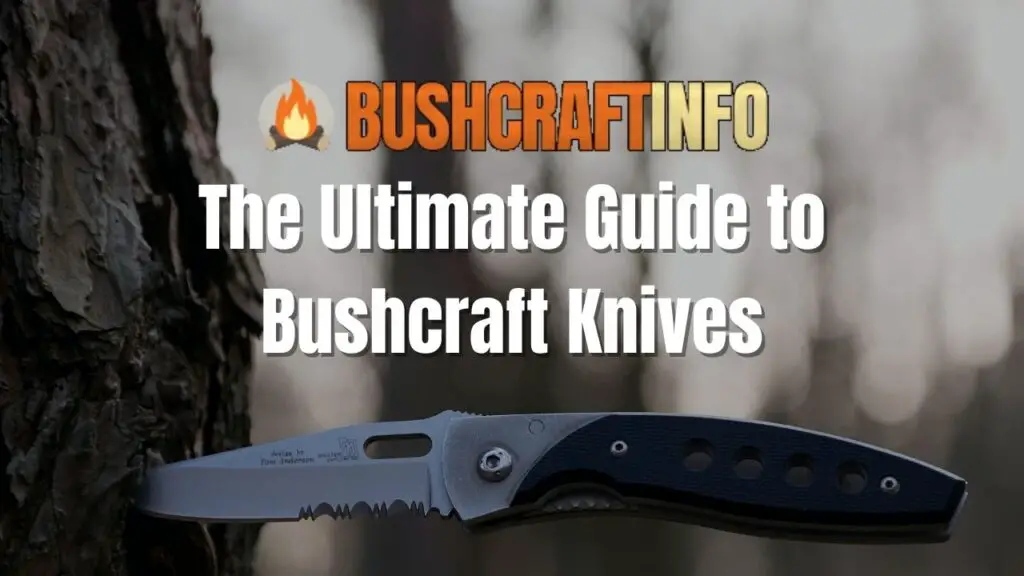
How Many Knives You Should Have for Bushcraft
It’s a common question. Surely we all know there are many types of bushcraft knives out there, some serve purposes others don’t.
Some are bigger than others, some even fold whereas others are full tang. The question is, how many knives do you need for bushcraft?
You need at least three knives for bushcraft:
- A 6-inch blade for wood processing and shelter construction.
- A 4.3-inch blade for making bow drill kits, feather sticks, and other carving tasks.
- A folding knife for butchering.
As mentioned, the 6-inch blade can be a full-tang blade which will be extremely helpful when processing wood during a survival situation. On top of that, you will need a shelter just in case it gets darker in the wilderness. With this full-tang blade, you can build a shelter too without any issues.
Apart from that, a Morakniv Kansbol knife with a 4.3-inch blade can help you create weapons such as a bow drill kit. It can also be used for feather sticks, saw frames, and other fine carving tasks.
Moreover, for small duty tasks such as butchering hunted animals and preparing food, you can use a foldable blade or knife.
What Types of Bushcraft Knives Are Out There?
The first thing that you must know is how many types of knives are available. The following are some of the main types of knives that are mostly used in bushcraft situations.
1. Full-Tang Knives
Full-tang knives are essentially made out of solid steel or stainless steel with a long wooden handle. Since these knives have no blade guard, they can cause serious injury if not held properly.
You should always hold the knife firmly when cutting into the wood to avoid slipping as well as use it as a screwdriver and to hit hard objects like nails.
2. Dagger Knives
Dagger knives, also known as “skinning” knives have a short tang which is about at least 3/4th the length of a full-tang knife. Most dagger knives were traditionally designed for skinning animals but nowadays they are used for bushcraft activities such as hunting game birds, fish, edible plants, etc.
3. Spear Knives
Spear knives are the smallest category among all bushcraft knives and are usually used for small tasks such as opening tin cans and boxes or digging holes. These knives are relatively light and handy.
This makes them perfect for carrying around whilst bushcrafting. Even though they are very handy, they are not recommended for bigger tasks due to their limited strength and sharpness.
As they do not have any extra features like serrations on the edge of the blade, they cannot be used for self-defense purposes.
It should also be noted that most spear knives are poorly made blades that will easily break after being dropped or stepped on.
4. Fixed-Blade Knives
Fixed-blades are the most powerful among all bushcraft knives. They are heavy and bulky compared to the other types of knives because of the addition of a steel handle.
When using fixed-blades, it is highly recommended to wear leather gloves to prevent getting hurt during your training sessions.
5. Hunting Knife Sets
Hunting knife sets are basically used for hunting big mammals such as deer and elk. These knives include two separate blades, one longer than the other so that each person has his own blade. This design allows the hunter to quickly switch between the two blades.
6. Folding Knives
These knives fold up into a compact size and hence make them ideal for hiking and camping trips. You must remember to carry this type of bushcraft knife with care once you reach your destination since they are easy to lose or drop when walking through rough terrains.
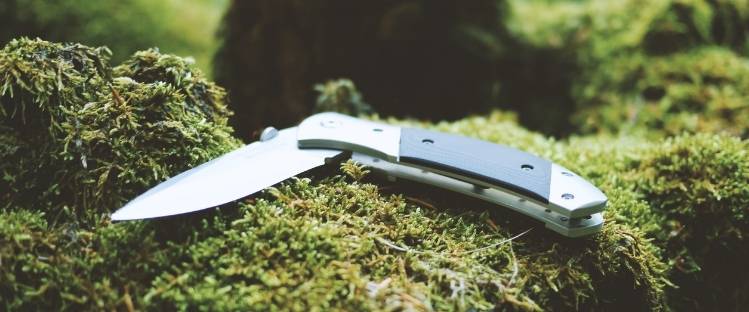
Selecting the Right Type of Knife Handle
Knife handles come in numerous sizes and shapes depending on the purpose they are meant for. There are four main categories:
Wooden Handles
Wooden handles are mainly used for making axes, hatchets, machetes, and bow drills. They are made using softwood trees like pine, maple, cedar, and other woods.
Wooden knife handles are generally more durable than those made from aluminum and steel but they are heavier than others too.
Aluminum Handles
Aluminum handles are mostly preferred by people who want to keep their knives lightweight. They are generally less expensive compared to wooden handles but their durability is questionable compared to wooden ones.
Aluminum handles cannot take much weight (aside from what the actual blade can hold). If the weight exceeds the limit, it might bend and cause damage to the blade.
If you need a strong material for your knife handle but still want it to be lightweight, then you can opt for a combination of aluminum and wood. For example, you could use aluminum for the bottom and side sections of the handle while using wood for the top section.
Steel Handles
Steel handles are generally considered to be the strongest among all hand-crafted knife handles available today. They are usually created using stainless steel which increases their durability. The downside to steel handles is their weight which tends to weigh a lot more than the other two options.
Most commercial knives use steel handles nowadays. It would be best if you get a custom-made steel-handled knife from a reputable maker instead of just buying a new knife set.
Titanium Handles
Titanium handles have been gaining popularity over the years due to their high corrosion resistance to water and oil. Its hardness is also superior to other metals, especially iron and steel. However, titanium is very expensive.
Choosing a Quality Blade
In addition to deciding on the type of bushcraft knife handle you want, you should also ensure that the quality of the blade matches your budget. Here’s a look at some factors you should consider before purchasing a good knife.
1. Blade Length
Generally speaking, longer blades tend to be better than shorter ones. Longer blades help to maximize their effectiveness and balance during use.
Short blades require multiple cuts for achieving the same tasks as longer blades. A long blade may not always be required, however, depending on the type of work you plan to do.
2. Blade Thickness
Another factor to consider is the thickness of the blade. A thicker blade will make a stronger cut with fewer strokes and therefore conserve energy. Thicker blades can also give you greater control over the object being cut.
When cutting thin objects, you first slice through them quickly and then go in again to finish off the job. On the contrary, whenever you are cutting delicate and thin objects such as meat, vegetables, or anything similar, you will need to choose thinner blades.
Thinner blades are not that strong and may break easily during the job, therefore, you shouldn’t use them for hardcore tasks such as tree pruning and stuff like that.
3. Handle Material
Depending on the style of knife you wish to buy, you may opt for a certain type of handle material. Hardwoods such as ash, hickory, oak, maple, walnut, and mahogany are examples of common woods used for making handles. You should also consider your own preferences since every person has a unique sense of aesthetics.
4. Style
Each individual prefers something different when shopping for a particular type of knife. Some people prefer single-edge knives while others like double-edged designs.
In most cases, a multi-purpose knife works well for both chopping and slicing purposes. With that said, here’s a quick overview of what makes each style of knife special:
- Double-Edged Knife: This type of knife features two cutting edges to allow you to perform different functions. For example, one edge could be used to chop wood while the other is used for slicing vegetables.
- Single-Edge Knife: Single-edge knives feature only one cutting edge. Most professional chefs prefer these knives because they offer easier handling. If you need to make a fine cut, you might find yourself having to move the knife back and forth between the handle and the blade many times.
5. Durability
Durability refers to how well a knife retains its sharpness after continuous use and abuse. In general, high carbon steel (HC) makes for a strong knife but it tends to wear out quickly which means frequent replacements are needed.
Steel with higher chromium content (such as Damascus steel or D2) will last considerably longer and retain its quality even after heavy use.
6. Blades
This refers to the shape and pattern of the cutting tip. The most important thing to look at is whether the tip is convex or concave so that it won’t roll away during use.
It also matters whether the tip is pointed or rounded. Pointy tips can help you easily pierce through objects without causing unnecessary damage to the surrounding areas.
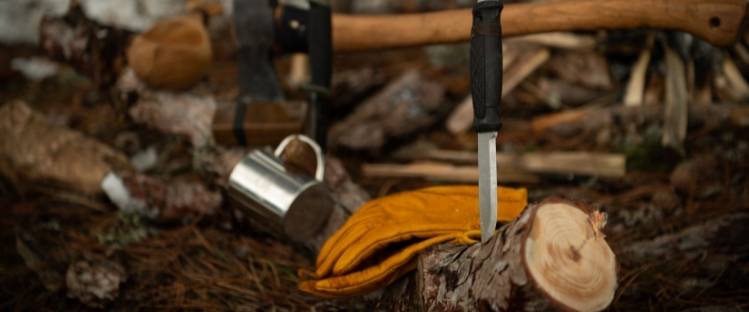
7. Size
One aspect of choosing the right bushcraft knife is size. As mentioned earlier, it’s best if you have a balanced grip when using a bushcraft knife. Choose a model that fits all of your hands comfortably.
Bushcraft Blades: Choosing the Best for the Job
The blade of a knife is what makes it great, and selecting the perfect blade may not be easy for everyone. As a beginner prepper, you may feel confused, especially when just getting started.
Don’t worry, I will make it simple for you so that you don’t face any problems while choosing the right blade for the task.
1. Large Bushcraft Knives
For tasks such as shelter building and batoning wood, you want to be sure you have a thick, long blade (preferably around 6 inches minimum). If you try to baton wood with a smaller blade, you can seriously damage it.
Larger blades can take on the more intensive tasks that often come with building bushcraft shelters whereas other sized blades wouldn’t keep up. It is important to select the right tools for the right job.
2. Medium Bushcraft Knives
For things like cleaning fish, cutting up food, making feather sticks, and other various bushcraft projects that require fine carving it is recommended to have a medium-sized blade (around 4 inches).
The reason is that you have more control over the medium-sized bushcraft blade as opposed to a larger, thick blade.
3. Compact Folding Bushcraft Knives
Carrying a compact folding bushcraft knife in my pocket has come in handy more times than I can count. These tend to sport a smaller-sized blade that obviously won’t be used for major tasks.
They are very compactable. Just throw one in your pocket and it won’t weigh you down and you’ll have it when you need it. Typically I will pull out my folding bushcraft blade for things like eating, carving, and everyday cutting (things like fishing line).
What About Blade Coatings?
The idea behind coating is to protect the metal surface from rusting and chipping. Different types of coatings include hard chrome, nickel, stainless steel, epoxy, and polyester.
All these coatings provide various benefits such as improving corrosion resistance, providing better durability, enhancing safety, and ensuring a smooth-cutting action.
How Thick Should a Bushcraft Knife Be?
A good knife must be sturdy enough to withstand harsh conditions yet thin enough not to add much weight to your backpack.
The thickness of the knife refers to the total distance between the centerline of the blade and the guard. While thicker blades are more durable, thinner blades tend to slice faster. A balance between speed and strength is key.
How Long Should Bushcraft Knives Be?
After the thickness of the knife, you might be thinking, how long should my bushcraft knives be? The answer is:
The length of the bushcraft knife depends on several factors. For instance, the main full-tang blades need to be at least 6 inches. This is because it will help you in processing wood for the fireplace and making shelter.
A 3-inch long knife can also help you in food preparation, weapon making, etc. Knives smaller than three inches can provide assistance in opening cans and butchering hunted animals.
What Is a Nying Knife Used For?
Nying knives are designed for multiple uses and come in different sizes. They are usually short and wide with a curved edge to help facilitate precision cuts and scalping.
These are made from black or tan ironwood. One advantage over traditional hunting knives is that nying knives can also function as utility knives. These are useful when making fires, harvesting food, or performing repairs.
Are Helle Knives Good For Bushcraft?
Helle knives are traditionally used for skinning game animals. However, bushcraft enthusiasts are now exploring new applications for them as well.
For example, this versatile tool can be used for carving, fishing hooks, scrapers, spears, axes, spear points, and even saw blades!
Bushcraft knives are often very specialized tools meant to perform specific tasks. When choosing a bushcraft knife, narrow down your choices first before going on a shopping spree. Only then would it be easy to make sure you have one that suits the purpose.
Which Bushcraft Knives Work Best?
Each has its own distinct features and strengths. Some are ideal for certain purposes while others fall short of expectations. It’s best to understand which type you need first before deciding what brand to buy.
There are two main categories of bushcraft knives: Utility and Survival.
Utility bushcraft knives are multipurpose tools designed for light daily chores like chopping firewood, cutting rope, and opening cans.
While some models may lack high-quality materials, they are still highly functional. The problem here is that although they look pretty good, they are too small for big game. Some of these models are suitable for outdoor adventures but can only handle light chores.
If you want to go for something bigger, try a survival knife. Those who are serious about bushcraft will prefer a fixed blade because they allow greater control than folding versions.
This category includes knives with a removable leather sheath. Here are some of the most recommended bushcraft knives:
- Off-Grid Knives – Tracker-X
- TOPS Knives B.O.B. Brothers of Bushcraft Knife
- Holtzman’s Gorilla Bushcraft Knife
What is the Difference Between Bushcraft and Survival Knives?
The difference between bushcraft knives and survival knives is not always clear-cut. This is mainly due to their design differences.
Many people believe bushcraft knives should focus primarily on survival skills. But there are many other ways you can use these tools. For instance, bushcraft knives are perfect for camping and hiking as well.
Survival knives are better suited for those who live in harsh environments or extreme conditions where access to medical care and emergency services are compromised.
So, if you want to do more than just self-defense, consider bushcraft knives. If you were stranded in an arctic region or lost at sea, your bushcraft knives could help you stay alive. The same goes for any situation where escape is needed.
Do Bushcraft Knives Really Matter?
Yes, bushcraft knives really do matter. They offer you superior quality tools and products compared to other types of kitchen knives. Unlike utility knives, bushcraft knives have sharp edges and high-grade steel blades. These make them easier when using them in tough situations.
They also have handles made from wood or bone to ensure long durability. Finally, they come with built-in safety mechanisms, unlike ordinary knives. This means no accidents ever occur when cutting yourself with the wrong tool.
Bushcraft knives are usually smaller than regular knives. However, this isn’t necessarily a disadvantage. In fact, smaller knives are much lighter compared to larger ones.
Most bushcraft knives are manufactured by hand, especially for hunting, fishing, and wilderness activities. This makes them more durable and longer-lasting.
Is a Machete a Bushcraft Knife or Survival Knife?
Not all machetes are bushcraft knives. Some can be used as both bushcraft and survival knives. Others can only be used for certain purposes – either bushcraft or survival.
There are two main types of machetes: single-edged and double-edged. A multi-purpose machete may be ideal for some applications, yet it lacks versatility and power. It requires training to master its functions properly.
A bushcraft machete has one edge. Usually, it comes with serrations on its backside. This allows the user to cut through thick sticks, branches, and twigs easily.
You can use the bushcraft machete to dig roots out of rocks. It helps you build shelters and firewood. Other uses include making weapons from tree trunks, carving spearheads, and creating axes that can be used for cutting down trees.
On the other hand, a survival knife works better when cutting through hard materials or heavy vegetation. Its tip becomes sharper over time so that you don’t need to sharpen it regularly.
It’s best to use your bushcraft knife for tasks that require a lot of strength and skill such as chopping off logs. When it comes to fighting or defending against wild animals, your survival knife will suit you better.
A survival knife is designed to handle rough conditions. You’ll notice that it has a fuller blade and a thicker handle. Such features improve its strength and efficiency. It’s strong enough not only to withstand falls but also to survive extreme weather conditions.
Final Words
Bushcraft knives are one of the essentials that you must carry with you whenever you are planning to go out on an adventure. However, you may not be fully aware of these knives and may sometimes confuse them with others.
To avoid this confusion, you must first know what type of knives are available and then understand what to look for when choosing the right knife.
After all this, you will be able to not only tell the difference between a survival knife and a bushcraft knife but you will also be able to buy the right one for your needs. I hope after reading the above article you have not only enjoyed it but also learned something new and interesting.
If you found this article helpful please share it with your friends and family too! Thank you for reading!
Was this post helpful?
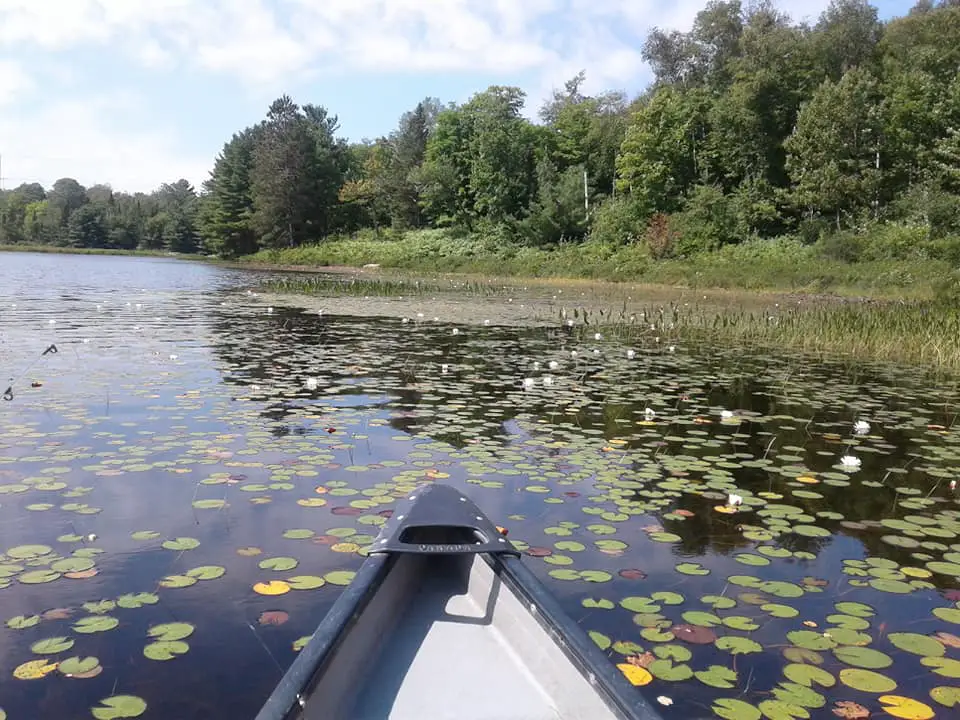
Hey I’m Josh! I have been practicing Bushcraft for a little over 6 years now! I Started this website to review awesome bushcraft gear that I love as well as share information I have learned along the way!

